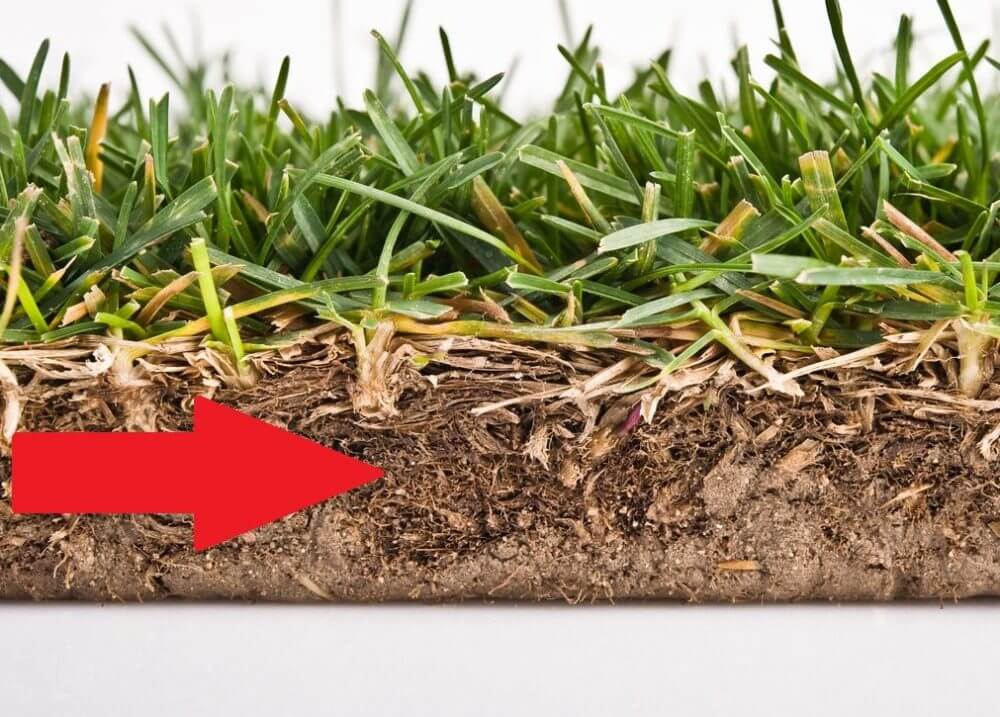I consistently hear folks telling me they plan to dethatch their lawn in the spring, despite my continual warnings against this practice. Many of our clients believe our treatments simply won’t work as well if they don’t first dethatch; that the applied products will not reach the soil. However, upon further investigation, most people are incorrectly calling surface dead leaves and debris thatch, and don’t really know what thatch is at all. This blog post will clear up the thatch mystique.
What is Thatch
Thatch is a layer of living and non-living plant material that forms between the grass plant and the soil as the turf grows. Thatch, contrary to common belief, is good for a lawn and is normal. A healthy thatch layer is generally considered beneficial up to ½” in thickness or less. Excessive thatch (½”and above) is an unusual phenomena which can occur over time with excessive fertilization and or improper maintenance such as avoiding annual core aeration. Most lawns don’t have a thatch issue, especially with proper care.
Why Thatch is Beneficial
Thatch is beneficial because it acts as a blanket on the lawn surface helping to keep the soil cooler and reduce weeds from germinating. Thatch, especially on athletic fields, acts as a protective layer when players fall and hit the ground. Statistics are clear that live turf game-playing provides protection and there are less serious injuries. Thatch is good.
When Thatch is a Problem
Excessive thatch can be a problem as it attracts and harbors damaging insects like chinch bugs. An excessive thatch layer can also act as a dry sponge, in fact repelling water during the drier summer months. Bluegrass, common in sodded lawns, is an aggressive thatch maker. If dethatching is necessary, then fall is a better time frame. See next paragraph for why dethatching in the spring is strongly not advised.
Dethatching Damage
Dethatching in the spring is a bad procedure for several reasons. First, it tears and rips turf that is often still dormant and therefore will be unable to recover after winter injury, snow mold and ice damage. Spring dethatching hits a lawn hard when it is already in a precarious condition. Secondly, dethatching in the spring with power equipment can bring up crabgrass and other noxious weed seeds, setting your lawn up for a future infestation.
The true tragedy of dethatching is that the tearing action that thins and damages a normal lawn is a procedure that for the vast majority of lawns is not even needed. The process is often done with good intentions, to remove old leaves or debris and for many, it just feels good to get out and dethatch. If your lawn does have an excessive thatch layer, over ½”, then dethatching is warranted, but do it in the fall when you don’t have to worry about damaging vulnerable spring grass or causing crabgrass and other weed seeds to germinate.
In my experience, I have seen perfectly healthy lawns thinned to actually destroyed from spring dethatching. I say, do something more productive, not destructive to your lawn this spring. Your lawn will love a light raking to remove leaves and surface debris.

Why Dethatching Can Hurt Your Lawn
Tags:
chippers
, dethatching
, concord lawn care
, thatch
, upper valley lawn care
, chinch bugs
, nh lawn care
, vt lawn care
, spring lawn care
, thatching

